 Technology peripherals
Technology peripherals
 AI
AI
 Stanford HAI releases latest white paper: The United States has been making slow progress in its AI national strategy for two years
Stanford HAI releases latest white paper: The United States has been making slow progress in its AI national strategy for two years
Stanford HAI releases latest white paper: The United States has been making slow progress in its AI national strategy for two years
Recently, the Stanford HAI Institute and the Stanford Regulation, Evaluation and Governance Laboratory jointly released the white paper "Implementation Challenges of the Three Pillars of the U.S. Artificial Intelligence Strategy", which systematically evaluates the progress of the United States in artificial intelligence. Condition.
The white paper mainly focuses on the three pillars of AI innovation and trustworthy AI:
1. The Artificial Intelligence in Government Act of 2020 》;
2. Executive Order on “Artificial Intelligence Leadership”;
3. Executive Order on “Artificial Intelligence in Government” executive order.
Taken together, these executive orders and the Artificial Intelligence in Government Act are critical to ensuring the United States’ national strategy for artificial intelligence, which is, simply put, “a strategic plan for the next decade.” the competitive advantage of the rest of the world."
After comprehensively examining the implementation status of each requirement in more than 200 federal agencies, the author found that although the United States has made a lot of progress in artificial intelligence innovation, it also faces There is a certain problem:
- Less than 40% of all requirements can be publicly verified as having been implemented.
- 88% of surveyed agencies failed to provide an AI plan identifying regulators related to AI.
- About half or more agencies have not submitted lists of AI use cases as required by the Artificial Intelligence in Government Order.
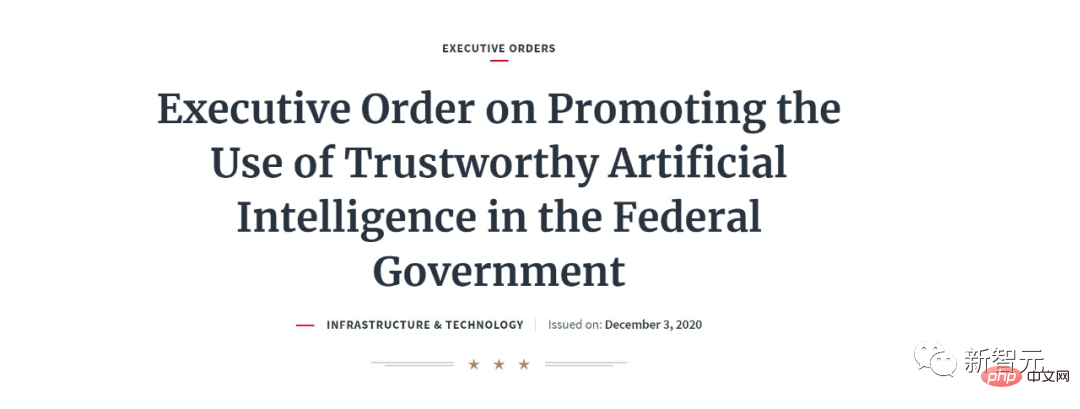
Summary
The transformative potential of artificial intelligence (AI) is an indisputable fact.
To take advantage of the “Fourth Industrial Revolution” or the “Third Wave of Digital Revolution”, countries are prioritizing efforts to restructure their public and private sectors and fund research and development (R&D). ), and create structures and policies that unleash AI innovation.
In the United States, the White House and Congress are promoting AI innovation and its trustworthy deployment by increasing investments in R&D and exploring ways to increase equitable access to AI-related resources through national AI research resources. Mechanism, funding National Artificial Intelligence Institutes across the country, directing $280 billion to domestic semiconductor manufacturing and "future industries" through CHIPS and the Science Act, and coordinating AI policy at the White House's Office of the National Artificial Intelligence Initiative.
1. National Strategy for Artificial Intelligence: Executive Order and Legislation
While the Artificial Intelligence Leadership Order seeks to drive technological breakthroughs across all U.S. sectors, the other two efforts focus on Federal use of artificial intelligence.
Executive Order 13859
The Artificial Intelligence Leadership Order launched the American Artificial Intelligence Initiative to "centralize the federal government's resources to develop artificial intelligence to increase American prosperity, strengthen American national and economic security, and improve the quality of life of the American people.”
Specifically, it seeks to accelerate the federal government’s Efforts to build U.S. leadership in AI through a multi-pronged approach that emphasizes AI research and development, AI-related data and resources, regulatory guidance and technical standards, the AI workforce, public trust in AI, and international engagement The infrastructure, policy foundation and talent required for the status.
Additionally, a "coordinated federal government strategy" is necessary and AI "will impact the missions of nearly all executive departments and agencies," the AI leadership order further empowers agencies to pursue Six related strategic goals to “promote and protect U.S. progress in artificial intelligence.”
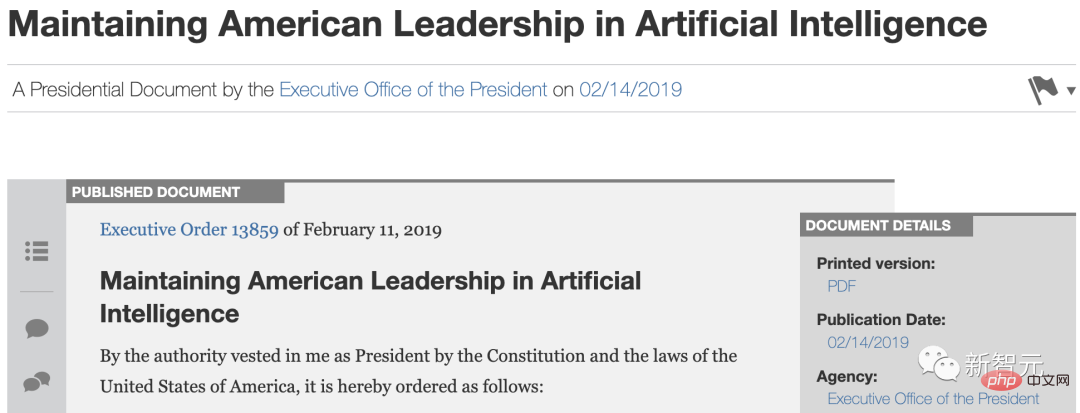
Executive Order 13960
The Artificial Intelligence in Government order directs federal agencies to harness the "potential of artificial intelligence to improve government operations." Recognizing that "continued adoption and acceptance of AI will depend heavily on public trust," the AI in Government order spells out nine principles that federal agencies should implement when designing, developing, acquiring, and using AI. .
These principles stipulate that artificial intelligence should be (a) lawful, (b) performance-driven, (c) accurate, reliable and effective, (d) safe, reliable and Resilient, (e) understandable, (f) accountable and traceable, (g) regularly monitored, (h) transparent, and (i) accountable.
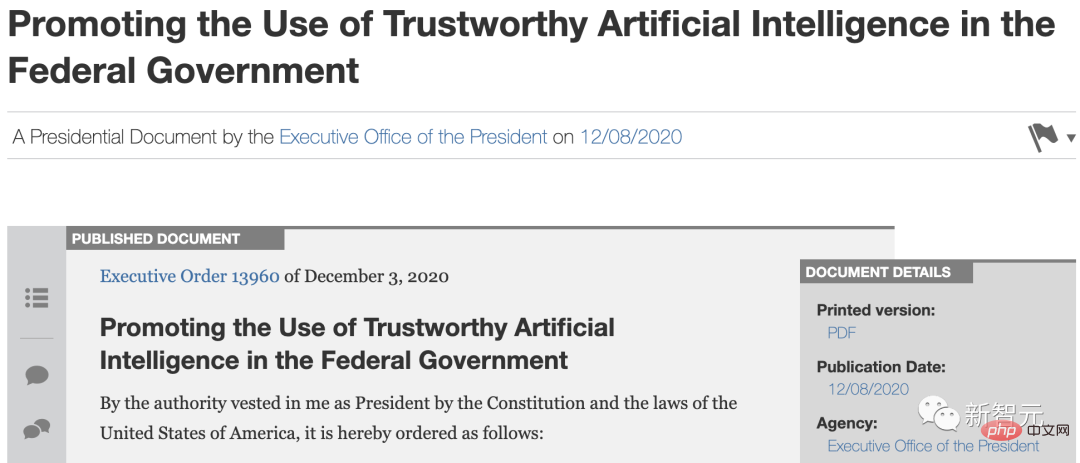
##Artificial Intelligence in Government Act of 2020
The Act Attempts to “ensure that the use of artificial intelligence across the federal government is effective, ethical, and responsible by providing resources and guidance to federal agencies.” This includes establishing an Artificial Intelligence Career Series that calls for agency use, procurement, artificial intelligence Intelligent Bias Assessment and Mitigation provides formal guidance and creates a center of excellence within the General Services Administration (GSA) to support government adoption of artificial intelligence.
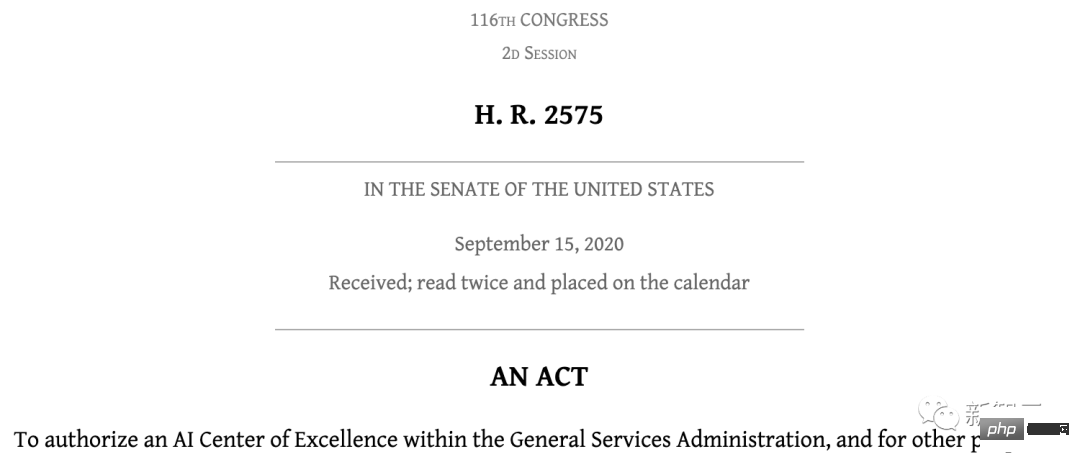
The author studied each of the two executive orders and the Artificial Intelligence in Government Act. The implementation of the regulations of each department.
In the above two executive orders and the Artificial Intelligence in Government Act of 2020, the authors found that 11 of the 45 requirements, or approximately 27%, have been implemented.
However, 7 of the 45 requirements (16%) were not implemented by the deadline, and the remaining 26 requirements (58%) could not be confirmed whether they were fully implemented or not implemented.
Similarly, among the requirements that have already been implemented, the specific implementation status is also uncertain. This includes efforts to make data and source code more accessible for AI R&D, better leverage and create new AI-related education and workforce development programs, and ensure full agency engagement to further implement trustworthy AI.
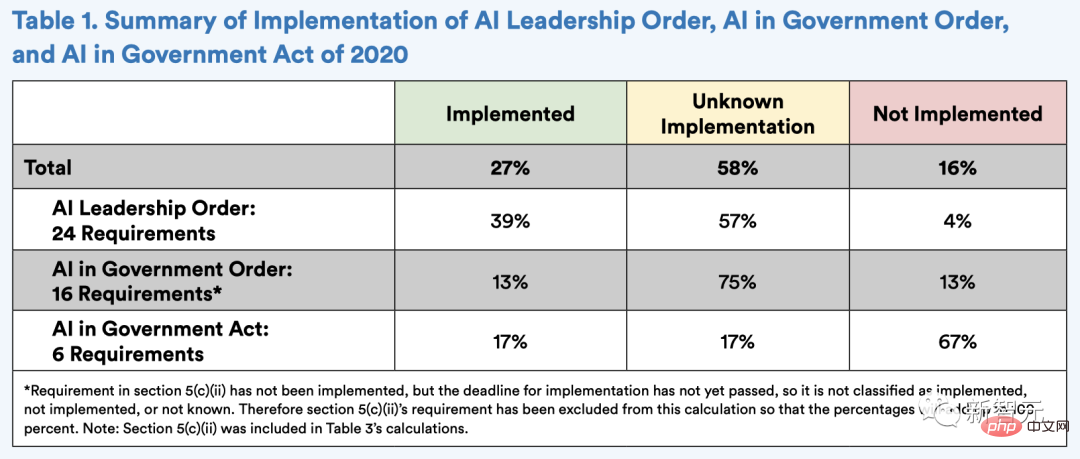
None of the Artificial Intelligence in Government Act’s four deadline requirements have been implemented:
- The Office of Personnel Management (OPM) should submit a plan to establish an AI career series to Congress by May 2021;
- OMB should issue a plan for AI procurement by October 2021 , Memorandum to Reduce Discriminatory Impact or Bias;
- Agencies should publicly release plans consistent with this by April 2022;
- OPM should create one by July 2022 Artificial Intelligence Career Series and estimates AI-related workforce needs for each federal agency.
Of the measures that have been implemented, many are behind schedule. For example, the National Science and Technology Council's (NSTC) Special Committee on Artificial Intelligence submitted its report to the president on better leveraging cloud computing technology 16 months after the deadline.
3. Agency’s AI PlansAs mentioned above, an important focus of these executive orders and bills is to “reduce barriers to the use of artificial intelligence technology to promote its innovative applications" while protecting civil liberties, privacy, American values, and the U.S. economic and national security.
Therefore, these decrees emphasize the review of the appropriate role of regulating artificial intelligence, hoping to "avoid regulatory or non-regulatory actions that unnecessarily impede innovation and growth in artificial intelligence." Two requests are critical to achieving this goal:
#1. Request OMB to issue a memorandum to agency heads providing guidance on how agencies should regulate artificial intelligence;
2. Require agencies with "regulatory authority" to develop and publicly publish a plan ("Agency Artificial Intelligence Plan") to "achieve consistency" with the guidance provided by OMB.
On November 17, 2020, OMB issued the Memorandum to Heads of Executive Departments and Agencies on Regulatory Guidance for Artificial Intelligence Applications (OMB M-21-06), urging agencies to adopt "A regulatory approach that promotes innovation and growth and generates trust while protecting America's core values."
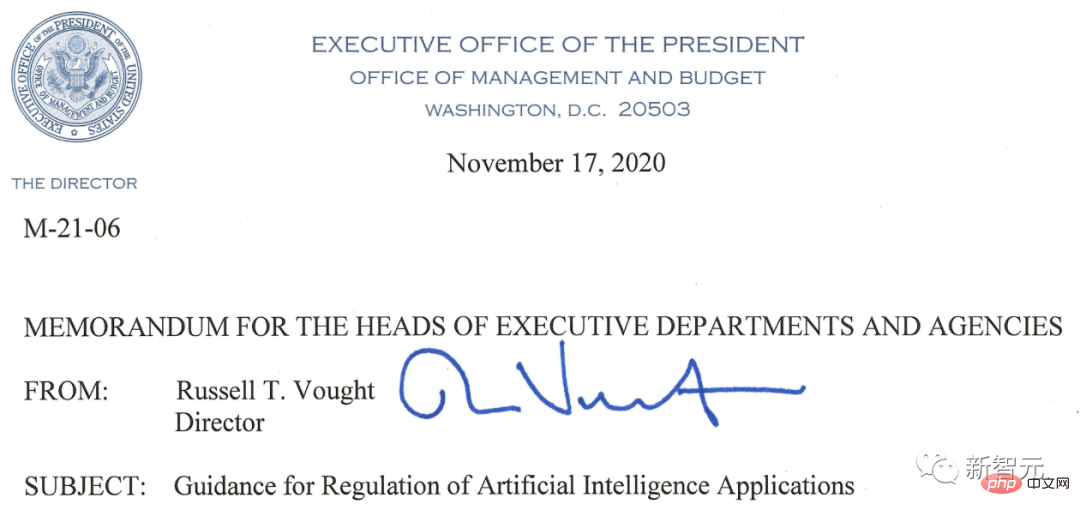
The memorandum delineates 10 principles for the management of artificial intelligence applications to guide various agencies’ regulatory and non-regulatory approaches to artificial intelligence, and determines the Non-regulatory approaches where regulation is inappropriate, and recommended actions for agencies to take to reduce barriers to deploying and using AI.
Agencies are required to submit plans by May 2021 (the deadline to comply with the Artificial Intelligence Leadership Order) and publicly post their plans on their agency websites.
Currently, only 5 of the 41 agencies assessed (13%) have published AI plans using the template provided by the OMB AI Regulation Memorandum. These agencies are the Departments of Energy (DOE), Health and Human Services (HHS), and Veterans Affairs (VA), as well as the Environmental Protection Agency (EPA) and the United States Agency for International Development (USAID).
The remaining 36 institutions have not announced their artificial intelligence plans.
4. List of AI Use Cases
The Artificial Intelligence in Government mandate is focused on promoting the development, adoption, and acquisition of trustworthy artificial intelligence within the federal government.
To that end, it requires agencies to "prepare a list of non-classified and non-sensitive use cases for artificial intelligence" and work with the federal Chief Information Officers Council (CIO Council) and other agencies and public sharing.
However, public disclosure of the list of AI use cases has been problematic.
Of the 220 agencies identified as potentially subject to this requirement, 168 do not have an independent inventory of AI use cases or incorporate their AI use cases into their parent agency’s in the list. Of the 78 parent agencies examined, only 17 published lists of AI use cases.
That is to say, among all 220 higher-level and lower-level institutions, 76% of the institutions did not publish the list, and 78% of the institutions did not publish the list in the upper-level evaluation.
In addition, among the 49 higher-level and lower-level institutions that are known to have artificial intelligence use cases, 47% of the institutions have not published a list of artificial intelligence use cases (23 upper-level and lower-level institutions). Of the narrowest group of institutions, the 23 large institutions with known AI use cases at the parent company level, only 11 have published AI inventories.

The lists themselves reflect the challenges faced during implementation.
First, agencies are not disclosing AI use cases, even though they have been publicly documented.
Second, institutions’ inconsistency in implementing AI use case checklists points to three key points that are not yet clear.
- No response:
For those agencies that did not publish a list, it is unclear whether they are asserting that they are not using artificial intelligence or simply This requirement was not fulfilled.
- Institutional Structure:
Except for the NIST list, all published lists are published at the parent agency level (e.g., Department of Commerce or the Department of Energy, not the lists published by NOAA or the Electric Power Administration). But it is unclear whether subagencies not listed in the list do not have relevant use cases, or whether they are unresponsive to the supposed parent agency's reporting requirements.
- Definition of AI:
The definition of artificial intelligence provided in the Fiscal Year 2019 NDAA and incorporated into government directives for artificial intelligence is likely to be quite broad. , which could make it more difficult for agencies to comply when classifying specific technologies as “artificial intelligence” for inventory purposes.
Third, agency lists often include existing transparency initiatives but vary widely.
5. Summary
Overall, the author believes that the three pillars of the U.S. artificial intelligence strategy are the artificial intelligence leadership order, the government artificial intelligence order and the government artificial intelligence law. , it is not ideal enough in actual operation.
The current requirements are viewed by many organizations as “unfunded tasks.” In response, Congress should provide agencies with the resources to staff and develop the technical expertise to develop strategic AI plans.
Failure to provide appropriate resources and empower senior personnel to carry out these responsibilities will likely undermine U.S. leadership in artificial intelligence.
About the author

Christie Lawrence is a JD/MPP candidate at Stanford Law School and Harvard Kennedy School, and Member of the Stanford Regulation, Evaluation, and Governance Laboratory (RegLab). She was the director of research and analysis at the National Security Council on Artificial Intelligence (NSCAI), and has worked at Stanford’s Institute for Human-Centered Artificial Intelligence, the Cyber Program at Harvard’s Belfer Center, the State Department, and as a management consultant. She holds a bachelor's degree in public policy from Duke University.

Isaac Cui is a first-year J.D. student at Stanford Law School, a member of the RegLab, and a Knight-Hennessy Scholar at Stanford University. He earned a bachelor's degree in physics and political science from Pomona College and a master's degree in applied social data science and a master's degree in regulation from the London School of Economics and Political Science, where he was a Marshall Scholar.

Daniel E. Ho is the William Benjamin Scott and Luna M. Scott Professor of Law, Professor of Political Science and Director of the Stanford Economic Policy Institute at Stanford University senior researcher. He is a designated member of the National Artificial Intelligence Advisory Council (NAIAC), associate director of the Institute for Human-Centered Artificial Intelligence (HAI) at Stanford University, a faculty fellow at the Center for Advanced Study in the Behavioral Sciences, and director of the Supervision Laboratory. He received his J.D. from Yale Law School and his Ph.D. from Harvard University.
The above is the detailed content of Stanford HAI releases latest white paper: The United States has been making slow progress in its AI national strategy for two years. For more information, please follow other related articles on the PHP Chinese website!

Hot AI Tools

Undresser.AI Undress
AI-powered app for creating realistic nude photos

AI Clothes Remover
Online AI tool for removing clothes from photos.

Undress AI Tool
Undress images for free

Clothoff.io
AI clothes remover

Video Face Swap
Swap faces in any video effortlessly with our completely free AI face swap tool!

Hot Article

Hot Tools

Notepad++7.3.1
Easy-to-use and free code editor

SublimeText3 Chinese version
Chinese version, very easy to use

Zend Studio 13.0.1
Powerful PHP integrated development environment

Dreamweaver CS6
Visual web development tools

SublimeText3 Mac version
God-level code editing software (SublimeText3)

Hot Topics
 1655
1655
 14
14
 1413
1413
 52
52
 1306
1306
 25
25
 1252
1252
 29
29
 1226
1226
 24
24
 Recommended reliable digital currency trading platforms. Top 10 digital currency exchanges in the world. 2025
Apr 28, 2025 pm 04:30 PM
Recommended reliable digital currency trading platforms. Top 10 digital currency exchanges in the world. 2025
Apr 28, 2025 pm 04:30 PM
Recommended reliable digital currency trading platforms: 1. OKX, 2. Binance, 3. Coinbase, 4. Kraken, 5. Huobi, 6. KuCoin, 7. Bitfinex, 8. Gemini, 9. Bitstamp, 10. Poloniex, these platforms are known for their security, user experience and diverse functions, suitable for users at different levels of digital currency transactions
 What are the top ten virtual currency trading apps? The latest digital currency exchange rankings
Apr 28, 2025 pm 08:03 PM
What are the top ten virtual currency trading apps? The latest digital currency exchange rankings
Apr 28, 2025 pm 08:03 PM
The top ten digital currency exchanges such as Binance, OKX, gate.io have improved their systems, efficient diversified transactions and strict security measures.
 Which of the top ten currency trading platforms in the world are the latest version of the top ten currency trading platforms
Apr 28, 2025 pm 08:09 PM
Which of the top ten currency trading platforms in the world are the latest version of the top ten currency trading platforms
Apr 28, 2025 pm 08:09 PM
The top ten cryptocurrency trading platforms in the world include Binance, OKX, Gate.io, Coinbase, Kraken, Huobi Global, Bitfinex, Bittrex, KuCoin and Poloniex, all of which provide a variety of trading methods and powerful security measures.
 What are the top currency trading platforms? The top 10 latest virtual currency exchanges
Apr 28, 2025 pm 08:06 PM
What are the top currency trading platforms? The top 10 latest virtual currency exchanges
Apr 28, 2025 pm 08:06 PM
Currently ranked among the top ten virtual currency exchanges: 1. Binance, 2. OKX, 3. Gate.io, 4. Coin library, 5. Siren, 6. Huobi Global Station, 7. Bybit, 8. Kucoin, 9. Bitcoin, 10. bit stamp.
 Decryption Gate.io Strategy Upgrade: How to Redefine Crypto Asset Management in MeMebox 2.0?
Apr 28, 2025 pm 03:33 PM
Decryption Gate.io Strategy Upgrade: How to Redefine Crypto Asset Management in MeMebox 2.0?
Apr 28, 2025 pm 03:33 PM
MeMebox 2.0 redefines crypto asset management through innovative architecture and performance breakthroughs. 1) It solves three major pain points: asset silos, income decay and paradox of security and convenience. 2) Through intelligent asset hubs, dynamic risk management and return enhancement engines, cross-chain transfer speed, average yield rate and security incident response speed are improved. 3) Provide users with asset visualization, policy automation and governance integration, realizing user value reconstruction. 4) Through ecological collaboration and compliance innovation, the overall effectiveness of the platform has been enhanced. 5) In the future, smart contract insurance pools, forecast market integration and AI-driven asset allocation will be launched to continue to lead the development of the industry.
 How much is Bitcoin worth
Apr 28, 2025 pm 07:42 PM
How much is Bitcoin worth
Apr 28, 2025 pm 07:42 PM
Bitcoin’s price ranges from $20,000 to $30,000. 1. Bitcoin’s price has fluctuated dramatically since 2009, reaching nearly $20,000 in 2017 and nearly $60,000 in 2021. 2. Prices are affected by factors such as market demand, supply, and macroeconomic environment. 3. Get real-time prices through exchanges, mobile apps and websites. 4. Bitcoin price is highly volatile, driven by market sentiment and external factors. 5. It has a certain relationship with traditional financial markets and is affected by global stock markets, the strength of the US dollar, etc. 6. The long-term trend is bullish, but risks need to be assessed with caution.
 Which of the top ten currency trading platforms in the world are among the top ten currency trading platforms in 2025
Apr 28, 2025 pm 08:12 PM
Which of the top ten currency trading platforms in the world are among the top ten currency trading platforms in 2025
Apr 28, 2025 pm 08:12 PM
The top ten cryptocurrency exchanges in the world in 2025 include Binance, OKX, Gate.io, Coinbase, Kraken, Huobi, Bitfinex, KuCoin, Bittrex and Poloniex, all of which are known for their high trading volume and security.
 How to use the chrono library in C?
Apr 28, 2025 pm 10:18 PM
How to use the chrono library in C?
Apr 28, 2025 pm 10:18 PM
Using the chrono library in C can allow you to control time and time intervals more accurately. Let's explore the charm of this library. C's chrono library is part of the standard library, which provides a modern way to deal with time and time intervals. For programmers who have suffered from time.h and ctime, chrono is undoubtedly a boon. It not only improves the readability and maintainability of the code, but also provides higher accuracy and flexibility. Let's start with the basics. The chrono library mainly includes the following key components: std::chrono::system_clock: represents the system clock, used to obtain the current time. std::chron



